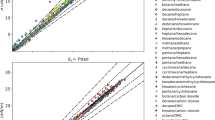Abstract
This work is to answer an important question: which parameter, surface concentration or surface excess, dominates the surface tension of multicomponent mixtures? Two series of solutions have been chosen to inspect the dependence of solution surface tension on surface concentration and surface excess of the solutes. The solutions are separately 1-palmitoyl-2-oleoyl-sn-glycero-3-phosphocholine (POPC) in 3-hydroxypropionitrile and tetrabutylphosphonium bromide (TBPBr) in formamide. The surface tension data of these two series of binary solutions have been respectively correlated to the Gibbs surface excess and the surface concentration of the solutes. Both surface excess and surface concentration are experimentally determined by Neutral Impact Ion Scattering Spectroscopy (NICISS). The surface tension of POPC solutions is linearly dependent on the surface concentrations of POPC; whereas, the surface tension of TBPBr solutions depends piecewise linearly on surface concentration but irregularly upon surface excess of TBPBr. The intrinsic linear relationships between surface tension and surface concentration found in those two series of solutions are consistent to those results found in previous work. This observation evidences that the dominant factor to the surface tension of solutions is the surface concentration of solute to which both the surface fraction and the molecular orientation are subject.



Similar content being viewed by others
References
Yano YF (2005) Correlation between surface and bulk structures of alcohol–water mixtures. J Coll Interf Sci 284(1):255–259. https://doi.org/10.1016/j.jcis.2004.09.059
Chodzinska A, Zdziennicka A, Janczuk B (2012) Volumetric and surface properties of short chain alcohols in aqueous solution–air systems at 293 K. J Solut Chem 41(12):2226–2245. https://doi.org/10.1007/s10953-012-9935-z
Wang C, Morgner H (2014) The dependence of surface tension on surface properties of ionic surfactant solution and the effects of counter-ions therein. Phys Chem Chem Phys 16(42):23386–23393. https://doi.org/10.1039/C4CP03607G
Kirmse K, Morgner H (2006) Binary liquid mixtures. The relation between surface tension and surface composition as studied by MIES (metastable induced electron spectroscopy). Langmuir 22(5):2193–2199. https://doi.org/10.1021/la052444k
Bermudez-Salguero C, Gracia-Fadrique J (2015) Phase segregation at the liquid−air interface prior to liquid−liquid equilibrium. J Phys Chem B 119(32):10304–10315. https://doi.org/10.1021/acs.jpcb.5b03450
Andersson G, Ridings C (2014) Ion scattering studies of molecular structure at liquid surfaces with applications in industrial and biological systems. Chem Rev 114(17):8361–8387. https://doi.org/10.1021/cr400417f
Rao Y, Li X, Lei X, Jockusch S, GeorgeMW TNJ, Eisenthal KB (2011) Observations of interfacial population and organization of surfactants with sum frequency generation and surface tension. J Phys Chem C115:12064–12067
Krebs T, Andersson G, Morgner H (2006) Chemical potential of a nonionic surfactant in solution. J. Phys. Chem B110:24015–24020
Andersson G, Krebs T, Morgner H (2005) Activity of surface active substances determined from their surface excess. Phys. Chem. Chem Phys 7(1):136–142. https://doi.org/10.1039/b412375a
Morgner H (2008) Behavior of surfactant molecules near the critical micelle concentration: a statistical treatment. J Phys Chem B 112(5):1383–1390. https://doi.org/10.1021/jp0763883
Pohl H, Krebs T, Morgner H (2010) Orientation of 1-palmitoyl-2-oleoyl-sn-glycero-3-phosphocholine at the surface of formamide and hydroxypropionitrile. Langmuir 26(4):2473–2476. https://doi.org/10.1021/la902706x
Wang C, Morgner H (2011) Surface structure of cationic surfactant solutions investigated by angular resolved X-ray photoelectron spectroscopy with calibrated transmission function. Surf Interface Anal 43(4):784–790. https://doi.org/10.1002/sia.3624
Acknowledgements
Financial support from National Natural Science Foundation of China (No. 21203251), Natural Science Foundation of Shandong (No. ZR2017LB013), and Fundamental Research Funds for the Central Universities (No. 15CX05066A and 15CX05052A) is gratefully thanked.
Author information
Authors and Affiliations
Corresponding author
Ethics declarations
Conflict of interest
The authors declare that they have no conflict of interest.
Rights and permissions
About this article
Cite this article
Wang, C., Wang, X., Liu, F. et al. Surface concentration or surface excess, which one dominates the surface tension of multicomponent mixtures?. Colloid Polym Sci 296, 89–93 (2018). https://doi.org/10.1007/s00396-017-4233-3
Received:
Accepted:
Published:
Issue Date:
DOI: https://doi.org/10.1007/s00396-017-4233-3




